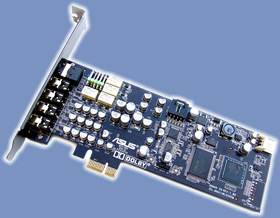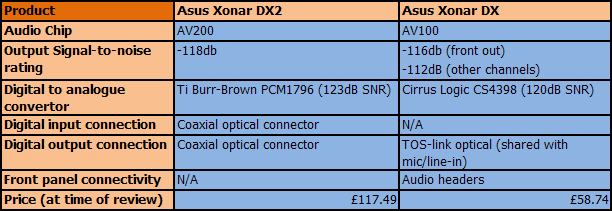ASUS Xonar DX 7.1 PCI-E Sound Card
 Asus have long been a leader in producing high quality, reliable hardware and components. Testament to this fact is that Asus are a ‘Tier 1’ manufacturer for Intel’s current chipset/motherboard offerings are also among the top manufacturers of both ATI and Nvidia based graphics cards along with their own brand of Notebooks and multimedia. Why then have Asus, up until recently, declined to enter into the soundcard sector, a market previously dominated by a one company – Creative? Only Asus can answer that question I’m afraid but I suspect it comes down to the number of people who value a soundcard over the on-board alternatives most motherboards supply today. Much to my dismay, Creative had the soundcard market all but wrapped up and despite their X-FI range impressing it was sadly let down with poor driver support. Those who were early adopters of Windows Vista will testify that using vista along with an X-FI card was a very frustrating time. Anyone wishing to purchase a card had very limited choices available to them but times have now changed with the advent of relative newcomers such as Auzentech (based on Creative’s X-FI chipset), Razer and C-Media based offerings from Terratec and now Asus, the market is once more alive with choice, not only of manufacturers but of chipset based cards.
Asus have long been a leader in producing high quality, reliable hardware and components. Testament to this fact is that Asus are a ‘Tier 1’ manufacturer for Intel’s current chipset/motherboard offerings are also among the top manufacturers of both ATI and Nvidia based graphics cards along with their own brand of Notebooks and multimedia. Why then have Asus, up until recently, declined to enter into the soundcard sector, a market previously dominated by a one company – Creative? Only Asus can answer that question I’m afraid but I suspect it comes down to the number of people who value a soundcard over the on-board alternatives most motherboards supply today. Much to my dismay, Creative had the soundcard market all but wrapped up and despite their X-FI range impressing it was sadly let down with poor driver support. Those who were early adopters of Windows Vista will testify that using vista along with an X-FI card was a very frustrating time. Anyone wishing to purchase a card had very limited choices available to them but times have now changed with the advent of relative newcomers such as Auzentech (based on Creative’s X-FI chipset), Razer and C-Media based offerings from Terratec and now Asus, the market is once more alive with choice, not only of manufacturers but of chipset based cards.|
Audio Performance
|
Output Signal-to-Noise Ratio (A-Weighted):
116 dB for Front-out 112dB for other channels Input Signal-to-Noise Ratio (A-Weighted): Output Total Harmonic Distortion + Noise at 1kHz (-3dB) : Input Total Harmonic Distortion + Noise at 1kHz (-3dB) : Frequency Response (-3dB, 24-bit/96kHz format): Output/Input Full-Scale Voltage |
|
Bus Compatibility
|
PCI Express
-PCI Express Rev.1.0a specification compatible -Max. full 2.5Gbps bandwidth per direction and optimized latency for high-definition audio processing -Compatible with X1, X4, X8, X16 PCI Express slots |
|
Main Chipset
|
Audio Processor
ASUS AV100 High-Definition Sound Processor (Max. 192KHz/24bit) 24-bit D-A Converter of Digital Sources: 24-bit A-D Converter for Analog Inputs: |
|
Sample Rate and Resolution
|
Analog Playback Sample Rate and Resolution
44.1K/48K/96K/192KHz @ 16/24bit Analog Recording Sample Rate and Resolution S/PDIF Digital Output |
|
I/O Ports
|
Analog Output Jack:
3.50mm mini jack *4 (Front/Side/Center-Subwoofer/Back) Analog Input Jack: Other line-level analog input (for TV Tuner or CD-ROM): Digital S/PDIF Output Front Panel Header |
|
Driver Features
|
Operation System
Windows Vista(32/64bit)/XP(32/64bit)/MCE2005 Dolby® Digital Live Dolby® Headphone Dolby® Virtual Speaker Dolby® Pro-Logic IIx DS3D GX 2.0 VocalFX™ Acoustic Echo Cancellation (AEC) Smart Volume Normalizer™ Karaoke Functions FlexBass™ Xear 3D™ Virtual Speaker Shifter Other Effects 3D Gaming Sound Engines/APIs ASIO 2.0 Driver Support: |
|
Bundled Software Utility
|
Portable Music Processor Lite utility
Converts digital music content or CD audio into regular MP3/WMA files with Dolby Headphone, Dolby Virtual Speaker (w/ Pro-Logic II), and Smart Volume Normalization processing (Windows Media Player 10 or above is required) MCE Software Kit RightMark Audio Analyzer 6.0.6 |



